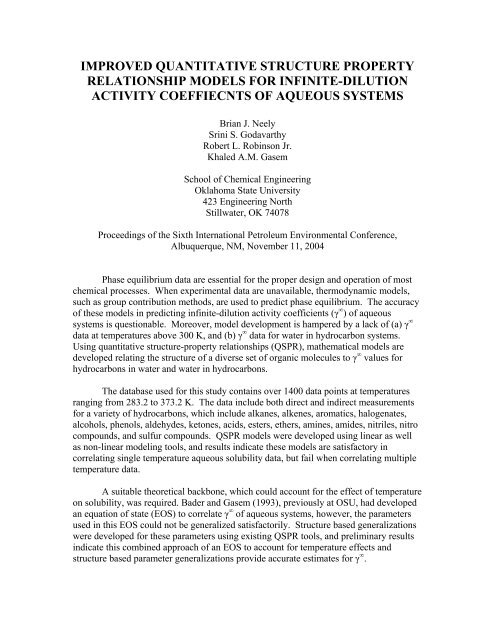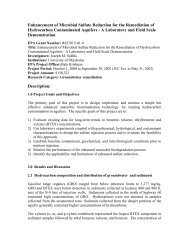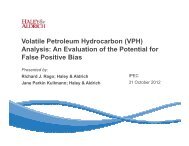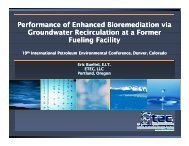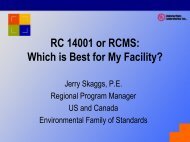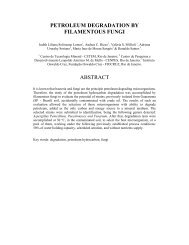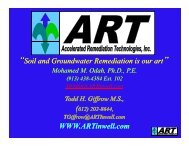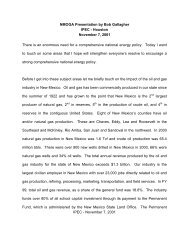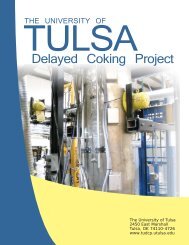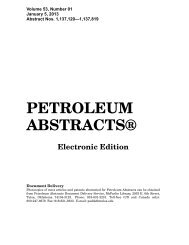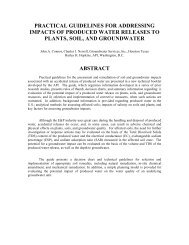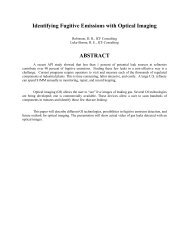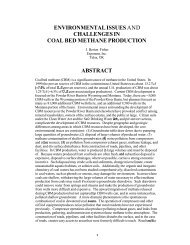THE SOLUBILITY OF HYDROCARBONS IN WATER - IPEC
THE SOLUBILITY OF HYDROCARBONS IN WATER - IPEC
THE SOLUBILITY OF HYDROCARBONS IN WATER - IPEC
You also want an ePaper? Increase the reach of your titles
YUMPU automatically turns print PDFs into web optimized ePapers that Google loves.
shown by the improvement in the training set %AAD, these numbers illustrate thatimprovement in the training set correlation with additional training comes at the expenseof a decrease in the predictive capability shown by the increase in %AAD for theprediction and cross validation sets. In this case for <strong>IN</strong>DEX1, replicate number ten with2000 training cycles would be selected. After selection of a particular replicate andnumber of training cycles, the results are obtained for the Type III models. The result forthe Type III analysis is presented in Table 5 and a plot for <strong>IN</strong>DEX1 is provided in Figure4.RESULTS AND DISCUSSIONA summary of the QSPR modeling results for <strong>IN</strong>DEX1 is presented in Table 5(for other case study results see [58]). In general the non-linear model performs betterthan the linear model in predicting the infinite-dilution activity coefficient. The backpropagationnetwork was used for generating the non-linear model. The resultingdescriptor set obtained for the Type III analysis provides insight into the relationshipbetween structural molecular features and physical properties of an organic molecule.Among the final descriptor set were two constructed descriptors, a functional groupparameter and a mathematical manipulation of the gravitational index. Hybrid models,which involve the use of descriptors obtained from linear methods to develop non-linearmodels, are increasingly being employed due to the decrease in the amount ofcomputational time required when using only non-linear methods.The new Type III model developed for predicting γ ∞ of hydrocarbon-watersystems provided satisfactory prediction of γ ∞ data (6.0 %AAD and R 2 of 0.988). Thedescriptors currently given in the literature and used in software packages do notadequately describe the molecular structure relationship with γ ∞ , but the addition ofconstructed descriptors improved the model predictions. However, predictions atextended temperatures are still poor. Since the majority of the data in the database arecollected at ambient temperature, the lack of extended temperature data results innetwork training skewed to ambient temperature data.A possible solution is the provision of a theoretical backbone to the model, whichaccounts for temperature dependence in the data. Preliminary study has been given to thedevelopment of an improved QSPR model, which is based on the Bader-Gasem equationof state [19]. Due to the need of inclusion of extended temperature data, application ofthis model has been limited to a small subset of the main database, but initial results of3.5 %AAD show marked improvement and are encouraging. Details of the other casestudies and further work concerning theoretical backbones for temperature dependencyare available from the Thermodynamics Group of the School of Chemical Engineering atOklahoma State University [58].
References[1] G. Malmary, A. Vezier, A. Robert, J. Mourgues, T. Conte, and J. Molinier,"Recovery of tartaric and malic acids from dilute aqueous effluents by solventextraction technique," Journal of Chemical Technology and Biotechnology, vol.60, pp. 67-71, 1994.[2] L. D. Skrylev, A. G. Nevinskii, and A. N. Purich, "Flotation extractionconcentration of dilute aqueous solutions of g-hexachlorocyclohexane," ZhurnalPrikladnoi Khimii (Sankt-Peterburg, Russian Federation), vol. 57, pp. 2026-30,1984.[3] C. L. Yaws, H. C. Yang, J. R. Hopper, and K. C. Hansen, "Organic chemicals:water solubility data," Chemical Engineering (New York, NY, United States), vol.97, pp. 115-16, 118, 1990.[4] C. L. Yaws, H. C. Yang, J. R. Hopper, and K. C. Hansen, "Hydrocarbons: watersolubility data," Chemical Engineering (New York, NY, United States), vol. 97,pp. 177-8, 180, 182, 1990.[5] T. Lazaridis and M. E. Paulaitis, "Activity coefficients in dilute aqueous solutionsfrom free energy simulations," AIChE Journal, vol. 39, pp. 1051-60, 1993.[6] J. Li, A. J. Dallas, D. I. Eikens, P. W. Carr, D. L. Bergmann, M. J. Hait, and C. A.Eckert, "Measurement of large infinite dilution activity coefficients ofnonelectrolytes in water by inert gas stripping and gas chromatography,"Analytical Chemistry, vol. 65, pp. 3212-18, 1993.[7] D. L. Bergmann and C. A. Eckert, "Measurement of limiting activity coefficientsfor aqueous systems by differential ebulliometry," Fluid Phase Equilibria, vol.63, pp. 141-50, 1991.[8] P. A. Belter, E. L. Cussler, and W. Hue, Bioseparations. New York: John Wiley& Sons, Inc., 1988.[9] M. S. H. Bader, "Vapor-Liquid Equilibrium Properties of Aqueous andSupercritical fluids at Infinite Dilution." Stillwater, OK: Oklahoma StateUniversity, 1993.[10] M. S. H. Bader and K. A. M. Gasem, "Determination of infinite dilution activitycoefficients for organic-aqueous systems using a dilute vapor-liquid equilibriummethod," Chemical Engineering Communications, vol. 140, pp. 41-72, 1996.[11] D. Tiegs, J. Gmehling, A. Medina, M. Soares, J. Bastos, P. Alessi, and I. Kikic,"Activity Coefficients at Infinite Dilution," in Chemistry Data Series, vol. IX,Part 1, D. Behrens and R. Eckermann, Eds. Frankfurt, Germany: Schoon &Wetzel GmbH, 1986.[12] G. Scatchard, "Equilibria in nonelectrolyte solutions in relation to the vaporpressures and densities of the components," Chemical Reviews (Washington, DC,United States), vol. 8, pp. 321-33, 1931.[13] J. H. Hildebrand and S. E. Wood, "Derivation of equations for regular solutions,"Journal of Chemical Physics, vol. 1, pp. 817-22, 1933.[14] R. F. Weimer and J. M. Prausnitz, "Screen extraction solvents this way,"Hydrocarbon Processing and Petroleum Refiner, vol. 44, pp. 237-42, 1965.
[15] C. M. Hansen, "Three-dimensional solubility parameter-key to paint componentaffinities. II. Dyes, emulsifiers, mutual solubility and compatibility, andpigments," Journal of Paint Technology, vol. 39, pp. 505-10, 1967.[16] J. G. Helpinstill and M. Van Winkle, "Prediction of infinite-dilution activitycoefficientsfor polar-polar binary systems," Industrial & Engineering ChemistryProcess Design and Development, vol. 7, pp. 213-20, 1968.[17] B. Karger, L. R. Snyder, and C. Eon, "An expanded solubility parametertreatment for classification and use of chromatographic solvents and adsorbents.Parameters for dispersion, dipole and hydrogen bonding interactions," Journal ofChromatography, vol. 125, pp. 71-88, 1976.[18] R. Tijssen, H. A. H. Billiet, and P. J. Schoenmakers, "Use of the solubilityparameter for predicting selectivity and retention in chromatography," Journal ofChromatography, vol. 122, pp. 185-203, 1976.[19] M. S. H. Bader and K. A. M. Gasem, "Modeling infinite dilution activitycoefficients of organic-aqueous systems using a modified regular solutionequation and cubic equations-of-state," Canadian Journal of ChemicalEngineering, vol. 76, pp. 94-103, 1998.[20] E. R. Thomas and C. A. Eckert, "Prediction of limiting activity coefficients by amodified separation of cohesive energy density model and UNIFAC," Industrial& Engineering Chemistry Process Design and Development, vol. 23, pp. 194-209,1984.[21] W. J. Howell, A. M. Karachewski, K. M. Stephenson, C. A. Eckert, J. H. Park, P.W. Carr, and S. C. Rutan, "An improved MOSCED equation for the predictionand application of infinite dilution activity coefficients," Fluid Phase Equilibria,vol. 52, pp. 151-60, 1989.[22] M. J. Hait, C. L. Liotta, C. A. Eckert, D. L. Bergmann, A. M. Karachewski, A. J.Dallas, D. I. Eikens, J. J. Li, and P. W. Carr, "Space predictor for infinite dilutionactivity coefficients," Industrial & Engineering Chemistry Research, vol. 32, pp.2905-14, 1993.[23] E. L. Derr and C. H. Deal, "Analytical Solutions of Groups Correlation ofActivity Coefficients Through Structural Group Parameters," Institute ofChemical Engineering Symposium Series, vol. 32, pp. 40, 1969.[24] A. Fredenslund, R. L. Jones, and J. M. Prausnitz, "Group-contribution estimationof activity coefficients in nonideal liquid mixtures," AIChE Journal, vol. 21, pp.1086-99, 1975.[25] J. Gmehling, J. Li, and M. Schiller, "A modified UNIFAC model. 2. Presentparameter matrix and results for different thermodynamic properties," Industrial& Engineering Chemistry Research, vol. 32, pp. 178-93, 1993.[26] G. J. Pierotti, C. H. Deal, and E. L. Derr, "Activity coefficients and molecularstructure," Journal of Industrial and Engineering Chemistry (Washington, D. C.),vol. 51, pp. 95-102, 1959.[27] C. Tsonopoulos and M. Prausnitz, "Activity Coefficients of Aromatic Solutes inDilute Aqueous Solutions," Industrial & Engineering Chemistry Fundamentals,vol. 10, pp. 593-600, 1971.
[28] M. Medir and F. Giralt, "Correlation of activity coefficients of hydrocarbons inwater at infinite dilution with molecular parameters," AIChE Journal, vol. 28, pp.341-3, 1982.[29] N. V. K. Dutt and D. H. L. Prasad, "Estimation of infinite dilution activitycoefficients of hydrocarbons in water from molar refraction," Fluid PhaseEquilibria, vol. 45, pp. 1-5, 1989.[30] S. H. Yalkowsky and S. C. Valvani, "Solubilities and partitioning. 2.Relationships between aqueous solubilities, partition coefficients, and molecularsurface areas of rigid aromatic hydrocarbons," Journal of Chemical andEngineering Data, vol. 24, pp. 127-9, 1979.[31] D. Mackay and W. Y. Shiu, "Aqueous solubility of polynuclear aromatichydrocarbons," Journal of Chemical and Engineering Data, vol. 22, pp. 399-402,1977.[32] R. W. Taft, J. L. M. Abboud, M. J. Kamlet, and M. H. Abraham, "Linearsolvation energy relations," Journal of Solution Chemistry, vol. 14, pp. 153-86,1985.[33] S. R. Sherman, D. B. Trampe, D. M. Bush, M. Schiller, C. A. Eckert, A. J. Dallas,J. Li, and P. W. Carr, "Compilation and Correlation of Limiting ActivityCoefficients of Nonelectrolytes in Water," Industrial & Engineering ChemistryResearch, vol. 35, pp. 1044-58, 1996.[34] K. S. Shing, "Infinite-dilution activity coefficients from computer simulation,"Chemical Physics Letters, vol. 119, pp. 149-51, 1985.[35] I. G. Economou, "Monte Carlo Simulation of Phase Equilibria of AqueousSystems," Fluid Phase Equilibria, vol. 183-184, pp. 259-269, 2001.[36] T. M. Nelson and P. C. Jurs, "Prediction of Aqueous Solubility of OrganicCompounds," Journal of Chemical Information and Computer Sciences, vol. 34,pp. 601-9, 1994.[37] B. E. Mitchell and P. C. Jurs, "Prediction of infinite dilution activity coefficientsof organic compounds in aqueous solution from molecular structure," Journal ofChemical Information and Computer Sciences, vol. 38, pp. 200-209, 1998.[38] J. He and C. Zhong, "A QSPR study of infinite dilution activity coefficients oforganic compounds in aqueous solutions," Fluid Phase Equilibria, vol. 205, pp.303-316, 2003.[39] P. D. T. Huibers and A. R. Katritzky, "Correlation of the Aqueous solubility ofHydrocarbons and Halogenated Hydrocarbons with Molecular Structure,"Journal of Chemical Information and Computer Science, vol. 38, pp. 283-292,1998.[40] M. G. Martin, J. I. Siepmann, and M. R. Schure, "Exploring multi-componentphase equilibria by Monte Carlo simulations: Towards a description of gas-liquidchromatography," Unified Chromatography, ACS Symposium Series, vol. 748,2000.[41] H. Kubinyi, "QSAR and 3D QSAR in Drug Design. 2. Applications andProblems," Drug Discov. Today, vol. 2, pp. 538-546, 1997.[42] K. Kojima, S. Zhang, and T. Hiaki, "Measuring Methods of Infinite-DilutionActivity Coefficients and a Database for Systems Including Water," Fluid PhaseEquilibria, vol. 131, pp. 145-179, 1997.
[43] "Chem3D Ultra," 6.0 ed. Cambridge, MA: CambridgeSoft.com, 2000.[44] "Chem3D Pro," 6.0 ed. Cambridge, MA: CambridgeSoft.com, 2000.[45] J. P. P. Stewart, "MOPAC Program Package," 1990.[46] "AMPAC," 6.7 ed. Shawnee Mission, KS: Semichem, 2000.[47] A. R. Katritzky, M. Karelson, V. S. Lobanov, R. Dennington, and T. Keith,"CODESSA," 2.63 ed. Shawnee, KS: Semichem, Inc., 1999.[48] A. R. Katritzky, V. S. Lobanov, and M. Karelson, "CODESSA User's Manual."University of Florida, Gainsville, 1994.[49] L. B. Kier and L. H. Hall, Molecular Connectivity in Structure-Activity Analysis.New York: Research Studies Press, 1986.[50] A. T. Balaban, "From Chemical Topology to 3D Geometry," J. Chem. Inf.Comput. Sci., vol. 37, pp. 645-650, 1997.[51] M. Karelson, Molecular Descriptors in QSAR/QSPR. New York: John Wiley &Sons, 2000.[52] R. Todeschini and V. Consonni, Handbook of Molecular Descriptors. Weinheim:Wiley-VCH, 2000.[53] M. Karelson, V. S. Lobanov, and A. R. Katritzky, "Quantum-ChemicalDescriptors in QSAR/QSPR Studies," Chem. Rev. (Washington, D.C.), vol. 96,pp. 1027-1043, 1996.[54] K. G. Joback and R. C. Reid, "Estimation of Pure-Component Properties fromGroup-Contributions," Chem. Eng. Communications, vol. 57, pp. 233, 1987.[55] L. Constantinou and R. Gani, "New Group Contribution Method for EstimatingProperties of Pure Compounds," AIChE Journal, vol. 40, pp. 1697, 1994.[56] M. Karelson, U. Maran, Y. Wang, and A. R. Katritzky, "QSPR and QSARModels Derived Using Large Molecular Descriptor Spaces. A Review of CodessaApplications. Collect.," Czech. Chem. Commun., vol. 64, pp. 1551-1571, 1999.[57] "NeuralPower," 2.5 ed: CPC-X Software, 2003.[58] B. J. Neely, "Improved Quantitative Structure Property Relationship Models forInfinite-Dilution Activity Coefficients of Aqueous Systems," in School ofChemical Engineering. Stillwater: Oklahoma State University, 2004.Table 1: Numerical Analysis of the DatabaseTypeData Error DataHydrocarbon in WaterDirect Measurement 776 438Indirect Measurement 388 0Water in Hydrocarbon 236 66
Table 2: Database Hydrocarbon StructuresHydrocarbon in WaterDirectIndirectWater in HydrocarbonAlkanes Aliphatic Alkanes Aliphatic AlkanesAlkenes Cyclic Alkanes Aromatic HydrocarbonsAromatic Hydrocarbons Aliphatic Alkenes Halogenated HydrocarbonsHalogenated Hydrocarbons Cyclic AlkenesAlcoholsAlcohols Alkynes KetonesPhenol and Derivatives Monocyclic Aromatics AcidsAldehydes Polycyclic Aromatics AldehydesKetonesHalogenated Hydrocarbons EthersAcids Alcohols EstersEsters Phenol Derivatives Compounds with NitrogenEthersKetonesAmines and Amides AcidsNitrilesEstersNitro Compounds EthersCompounds with Sulfur AldehydesAmines and AmidesNitro CompoundsCompounds with SulfurTable 3: Summary of Case StudiesCase StudyNumber ofValuesCase StudyNumber ofValuesDIRECT<strong>WATER</strong>Data Values 776 Data Values 236Error Values 438 Error Values 66Total 1214 Total 302<strong>IN</strong>DIRECT<strong>IN</strong>DEX2Data Values 388 DIRECT 410Total 388 <strong>IN</strong>DIRECT 30<strong>IN</strong>DEX1<strong>WATER</strong><strong>IN</strong>DDIRECT 776 DIRECT 410<strong>IN</strong>DIRECT 388 <strong>IN</strong>DIRECT 30<strong>WATER</strong> 236 <strong>WATER</strong> 154Total 1400 Total 594
Table 4: Summary of Type I ResultsResultsCase StudyDIRECT <strong>IN</strong>DIRECT <strong>WATER</strong> <strong>IN</strong>DEX1 <strong>IN</strong>DEX2 <strong>WATER</strong><strong>IN</strong>DR 2 with all Data at25 Parameters0.9802 0.9607 0.9800 0.9358 0.9048 0.9064Numbers of Outliers 64 21 17 72 40 46% of Outliers 5.3 5.4 5.6 5.1 6.7 7.7R 2 with CorrectedData at 250.9879 0.9767 0.9880 0.9686 0.9555 0.9507ParametersNumber ofDescriptors in35 40 33 39 46 47Final SetR 2 at 14Parameters0.9785 0.9617 0.9753 0.9485 0.9505 0.9364R 2 at 12Parameters0.9757 0.9533 0.9703 0.9370 0.9481 0.9323R 2 at 10Parameters0.9708 0.9465 0.9543 0.9336 0.9419 0.9230R 2 at 8Parameters0.9619 0.9243 0.9359 0.9197 0.9323 0.9057R 2 at 6Parameters0.9434 0.8997 0.8962 0.8979 0.9100 0.8724R 2 at 4Parameters0.8880 0.8622 0.8271 0.7871 0.8216 0.8048Table 5: Summary of QSPR Model ResultsResults<strong>IN</strong>DEX1Type I Type II Type II<strong>IN</strong>umbers of Descriptors 10 3 20R 2 0.937 0.956 0.988%AAD -- 10.0 6.0
25.0020.001400 Structures25 DescriptorsR 2 = 0.935872 data points to be eliminatedCalculated ln γ15.0010.005.000.00<strong>IN</strong>DEX1 ln γError Lines-5.00-5.00 0.00 5.00 10.00 15.00 20.00 25.00Experimental ln γFigure 1: Infinite-Dilution Activity Coefficients of <strong>IN</strong>DEX1 Case Study (Type I)25.0020.003 ParametersR 2 = 0.956%AAD = 10.0Calculated ln γ ∞15.0010.005.000.00Training setPrediction setCross validation set-5.00-5.00 0.00 5.00 10.00 15.00 20.00 25.00Experimental ln γ ∞Figure 2: Infinite-Dilution Activity Coefficients of <strong>IN</strong>DEX1 Case Study (Type II)
109870.91.01.11.21.4 1.31.51.51.61.51.41.31.21.11.01.11.21.31.41.41.31.21.11.11.11.21.31.21.1Replication6543211.31.11.2 1.11.11.01.0 1.01.1 1.11.01.01.2 1.1 1.11.31.2 1.2 1.21.31.41.3 1.31.41.51.41.41.41.41.41.31.31.31.21.21.21.21.11.11.11.11.11.3 1.21.21.41.11.31.51.0RMSE 1.11.22000 4000 6000 8000 10000Training CyclesFigure 3: Contour plot for <strong>IN</strong>DEX1 (Type III)25.0020.00R 2 = 0.987%AAD = 6.0Calculated ln γ ∞15.0010.005.000.00-5.00-5.00 0.00 5.00 10.00 15.00 20.00 25.00Experimental ln γ ∞Training setPrediction setCross validation setFigure 4: Infinite-Dilution Activity Coefficients of <strong>IN</strong>DEX1 Case Study (Type III)


